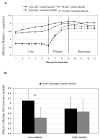Adapting to life's slings and arrows: Individual differences in resilience when recovering from an anticipated threat
- PMID: 19649310
- PMCID: PMC2711547
- DOI: 10.1016/j.jrp.2008.02.005
Adapting to life's slings and arrows: Individual differences in resilience when recovering from an anticipated threat
Abstract
Following highly negative events, people are deemed resilient if they maintain psychological stability and experience fewer mental health problems. The current research investigated how trait resilience (Block & Kremen, 1996, ER89) influences recovery from anticipated threats. Participants viewed cues ('aversive', 'threat', 'safety') that signified the likelihood of an upcoming picture (100% aversive, 50/50 aversive/neutral, or 100% neutral; respectively), and provided continuous affective ratings during the cue, picture, and after picture offset (recovery period). Participants high in trait resilience (HighR) exhibited more complete affective recovery (compared to LowR) after viewing a neutral picture that could have been aversive. Although other personality traits previously associated with resilience (i.e., optimism, extraversion, neuroticism) predicted affective responses during various portions of the task, none mediated the influence of trait resilience on affective recovery.
Figures





References
-
- Block J, Kremen AM. IQ and ego-resiliency: Conceptual and empirical connections and separateness. Journal of Personality and Social Psychology. 1996;70(2):349–361. - PubMed
-
- Bonanno GA. Loss, Trauma, and Human Resilience: Have We Underestimated the Human Capacity to Thrive After Extremely Aversive Events? American Psychologist. 2004;59(1):20–28. - PubMed
-
- Bonanno GA, Wortman CB, Lehman DR, Tweed RG, Haring M, Sonnega J, et al. Resilience to loss and chronic grief: A prospective study from preloss to 18-months postloss. Journal of Personality and Social Psychology. 2002;83(5):1150–1164. - PubMed
-
- Bonanno GA, Wortman CB, Nesse RM. Prospective Patterns of Resilience and Maladjustment During Widowhood. Psychology and Aging. 2004;19(2):260–271. - PubMed
-
- Cannon WB. The James-Lange theory of emotions: A critical examination and an alternative theory. American Journal of Psychology. 1927;39:106–124. - PubMed
Grants and funding
LinkOut - more resources
Full Text Sources
